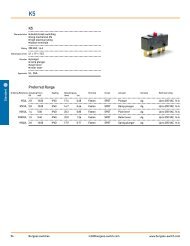Ledex® Rotary Solenoids - Contact Evolution Payerne
Ledex® Rotary Solenoids - Contact Evolution Payerne
Ledex® Rotary Solenoids - Contact Evolution Payerne
Create successful ePaper yourself
Turn your PDF publications into a flip-book with our unique Google optimized e-Paper software.
Ledex ® <strong>Rotary</strong> <strong>Solenoids</strong><br />
Modified and Custom-Designed <strong>Rotary</strong> <strong>Solenoids</strong><br />
Ledex offers comprehensive design and manufacturing<br />
resources to develop application specific rotary<br />
solenoids to meet your exact performance and unit cost<br />
objectives. Even though we offer thousands of standard<br />
rotary solenoid models, almost 80% of the product we<br />
build is specifically tailored to our customers’ needs. So<br />
if you don’t find exactly what you’re looking for, please<br />
call us to discuss your requirements. Here are a few<br />
simple design options which we frequently encounter<br />
for rotary solenoid applications:<br />
• Special shafts<br />
• Mounting studs threaded to customer specification<br />
• Slots, flats, or holes in shafts for machine linkage<br />
• Double return springs for critical safety redundancy<br />
• Armature covers<br />
In-Stock Models for Next Day Shipment<br />
across North America<br />
Many rotary solenoids are available from distribution<br />
inventory. If you’re not sure of your exact requirement,<br />
you may consider using a stock model prototype as<br />
a quick and very inexpensive means to determine<br />
your exact requirements. Stock models are available<br />
in a variety of rotary strokes for most sizes of bobbin,<br />
precision standard and precision elongated coil styles.<br />
De-Energized Energized<br />
Design Principles<br />
Physical Characteristics<br />
The rotary solenoid<br />
is a compact and<br />
rugged direct current<br />
electromagnet— almost<br />
solid steel and copper so<br />
as to give maximum power<br />
output with minimum<br />
size and weight. The coil<br />
is wound by a special<br />
precision winding process<br />
which puts the maximum<br />
amount of copper into<br />
the allowable space, thus<br />
resulting in each solenoid<br />
developing a tremendous<br />
torque for its size and<br />
power output. Heat-treated<br />
steel surrounds and<br />
protects the coil. The steel<br />
also provides a magnetic<br />
path of high permeability<br />
and low residual flux<br />
characteristics for efficient<br />
conversion of electrical<br />
energy to mechanical<br />
energy and fast response.<br />
Determining <strong>Rotary</strong><br />
Stroke<br />
The three ball races<br />
which determine the<br />
rotary stroke are produced<br />
by a coining process. The<br />
coining of the solenoid<br />
case and armature plate<br />
determines the length<br />
and direction of the<br />
stroke and the value of<br />
starting torque. Refer to<br />
the selection charts for the<br />
standard strokes available.<br />
Special rotary strokes<br />
can be engineered for<br />
solenoids which are made<br />
to order.<br />
Converting Linear to<br />
<strong>Rotary</strong> Motion<br />
The rotary solenoid<br />
armature is supported<br />
by three ball bearings<br />
that travel around and<br />
down inclined ball<br />
races. When power is<br />
applied, a powerful linear<br />
electromagnetic force<br />
pulls in the armature.<br />
Rotation continues until<br />
the balls have traveled<br />
to the deep ends of the<br />
races. The result is almost<br />
frictionless conversion<br />
from linear to rotary<br />
motion.<br />
High Starting Torque<br />
In ordinary<br />
electromagnets, magnetic<br />
pull increases sharply<br />
as the air gap closes. In<br />
Ledex rotary solenoids,<br />
this is compensated for<br />
by the compound angle<br />
of incline of the ball<br />
races. The incline of the<br />
ball races is steep at the<br />
beginning of the rotary<br />
stroke and gradually<br />
decreases as the balls<br />
approach the deep end<br />
of the ball races, thus<br />
transferring torque to the<br />
start of the rotary stroke<br />
where it is usually needed.<br />
Ledex ® <strong>Solenoids</strong> D3<br />
www.ledex.com 1.937.454.2345 Fax: 1.937.898.8624<br />
ROTARY <strong>Solenoids</strong>












